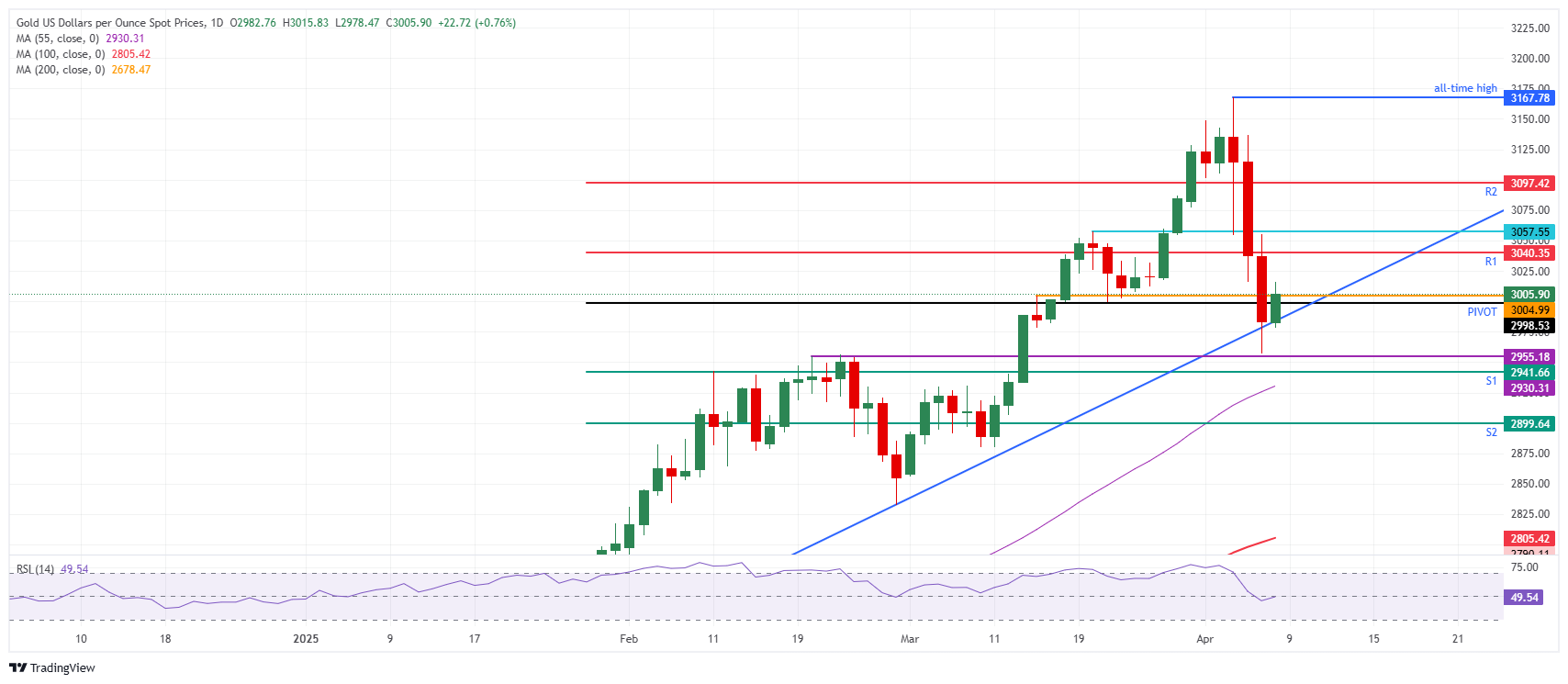Gold bounces back above $3,000 as trade war tensions flair up
- Gold price bounces off vital support and tries to end losing streak.
- Markets still favor Bullion as the safer bet for any stagflation or recession scenario.
- Gold bounces off from $2,955 and pops back above $3,010, gaining nearly 1% intraday.
Gold price (XAU/USD) is bouncing higher in tandem with Equities after another stellar nosedive move on Monday. The precious metal trades just above the $3,000 mark at the time of writing on Tuesday. The bounce is supported by a technical element on the one hand and a geopolitical driver on the other. That last one is the tit-for-tat war between China and the United States (US) spiraling out of control. US President Donald Trump threatened to impose an additional 50% tariff on Chinese imports.
Meanwhile, traders are sending the US yield curve all over the place. At a given point on Monday, investors were betting on five interest rate cuts from the Federal Reserve in 2025, quite a change compared to the one-or-none stance from just a week ago.
Daily digest market movers: Alerts flashing
- West Australia’s Gold Road Resources says a scoping study on its flagship asset suggests there is more Gold than first thought, a clear indication that a $3.3 billion takeover bid from its joint venture partner undervalues the company, Financial Review reports. On Tuesday, Gold Road Resources released new data that showed the open-pit mine could hold more ounces underground that can be tapped profitably.
- The CME FedWatch tool shows chances for an interest rate cut by the Fed in May’s meeting standing at 31.7%, falling back from nearly 50% on Monday. For June, the chances of a rate cut are 96.9%, with a slim 3.1% chance for no rate cut at all.
- In his latest move, Trump threatened to slap an additional 50% levy on Chinese imports, while Beijing responded by saying it’s prepared to “fight to the end.” Shares in Europe rebounded from the worst three-day loss in five years, while US equity-index futures pointed to gains on Wall Street after Monday’s dizzying swings. Treasuries advanced after Monday’s sharp selloff. Oil gained while Gold climbed for the first time in four days. The US Dollar slipped against major peers, Bloomberg reports.
Gold Price Technical Analysis: Not an easy recovery
Gold, known as a safe haven asset, is unable to withstand selling pressure when market turmoil spreads to all asset classes, as seen in the past few days. That is something to keep in mind, meaning that the precious metal will not recover back to the all-time high at $3,167 in a straight line, as trade war tensions are set to take place from here on out.
Looking up, resistances are a bit spread out, with the first cap at $3,040 as the R1 resistance, followed by $3,057, a pivotal level since March 20. Further up, the R2 resistance at $3,097 precedes the current all-time high at $3,167.
On the downside, the pivotal level of the March 14 high at $3,004 roughly coincides with the $3,000 round number and is trying to provide support as writing. If this area does not hold as support, bears can target $2,955, where clearly many buyers were interested in scooping up Gold on Monday. Further down, the S2 support at $2,899 is the last line of defence, with the 55-day Simple Moving Average (SMA) coming in already in advance at $2,930.

XAU/USD: Daily Chart
Gold FAQs
Gold has played a key role in human’s history as it has been widely used as a store of value and medium of exchange. Currently, apart from its shine and usage for jewelry, the precious metal is widely seen as a safe-haven asset, meaning that it is considered a good investment during turbulent times. Gold is also widely seen as a hedge against inflation and against depreciating currencies as it doesn’t rely on any specific issuer or government.
Central banks are the biggest Gold holders. In their aim to support their currencies in turbulent times, central banks tend to diversify their reserves and buy Gold to improve the perceived strength of the economy and the currency. High Gold reserves can be a source of trust for a country’s solvency. Central banks added 1,136 tonnes of Gold worth around $70 billion to their reserves in 2022, according to data from the World Gold Council. This is the highest yearly purchase since records began. Central banks from emerging economies such as China, India and Turkey are quickly increasing their Gold reserves.
Gold has an inverse correlation with the US Dollar and US Treasuries, which are both major reserve and safe-haven assets. When the Dollar depreciates, Gold tends to rise, enabling investors and central banks to diversify their assets in turbulent times. Gold is also inversely correlated with risk assets. A rally in the stock market tends to weaken Gold price, while sell-offs in riskier markets tend to favor the precious metal.
The price can move due to a wide range of factors. Geopolitical instability or fears of a deep recession can quickly make Gold price escalate due to its safe-haven status. As a yield-less asset, Gold tends to rise with lower interest rates, while higher cost of money usually weighs down on the yellow metal. Still, most moves depend on how the US Dollar (USD) behaves as the asset is priced in dollars (XAU/USD). A strong Dollar tends to keep the price of Gold controlled, whereas a weaker Dollar is likely to push Gold prices up.

